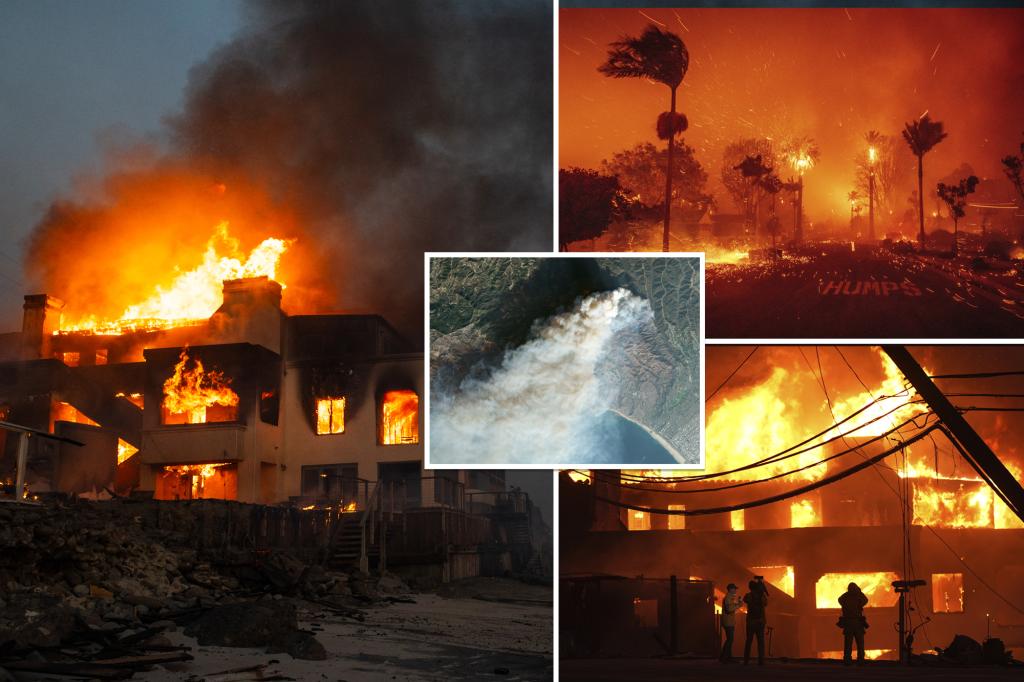The devastating wildfires sweeping through Los Angeles County continue to pose a significant threat, with three major blazes still raging nearly a week after ignition. Despite a brief reprieve over the weekend, the return of strong winds on Monday hampered firefighting efforts, raising concerns about further spread and destruction. The Pacific Palisades Fire, the largest of the three, has already scorched an area nearly three times the size of Manhattan, leaving a trail of devastation in its wake. Over 153,000 residents remain under mandatory evacuation orders, highlighting the widespread impact of this natural disaster. The collective death toll from the Palisades and Eaton fires has reached 24, with nine individuals still missing. Authorities have issued warnings about impending hurricane-force winds, which are expected to further complicate containment efforts. While expressing confidence in their preparedness and commitment to public safety, officials acknowledge the immense challenge posed by these extreme weather conditions.
The financial repercussions of these wildfires are staggering. AccuWeather estimates the total damages to range between $250 billion and $275 billion, a figure that would make this fire storm the costliest natural disaster in US history. This estimate underscores the immense scale of destruction and the long-term economic consequences that will undoubtedly follow. The impact is further magnified by the sheer population density of Los Angeles County, which is home to nearly 9.7 million residents – a number exceeding the population of all but 10 US states. This concentration of people and infrastructure within the fire zone contributes to the potential for widespread damage and displacement. The ongoing crisis serves as a stark reminder of the vulnerability of urban areas to large-scale natural disasters and the critical need for robust disaster preparedness and response mechanisms.
The Palisades Fire, the third most destructive in California’s history, remains a primary concern. Despite efforts by fire crews, containment remains at a frustratingly low 14%, a marginal improvement from the previous day’s 11%. The strong winds, expected to persist through midweek, pose a significant obstacle to containment efforts. While the official cause of the fire is still under investigation, authorities are exploring all possibilities, including arson. The Bureau of Alcohol, Tobacco, Firearms and Explosives is leading the investigation, seeking to determine the precise origin of this devastating blaze. Preliminary reports suggest two potential causes: re-ignition from smoldering embers of a smaller New Year’s Eve fire, and human activity along a popular hiking trail. Forensic analysis and eyewitness accounts are being meticulously examined to determine the most likely scenario.
The Eaton Fire, while smaller in acreage than the Palisades Fire, has proven to be the deadliest of the ongoing blazes. Having consumed 14,117 acres (22 square miles), the Eaton Fire has claimed 16 lives and destroyed 1,213 structures. Despite the challenging conditions, firefighters managed to increase containment to 33% on Monday, a testament to their relentless efforts in the face of adversity. The Hurst Fire, burning in the northern San Fernando Valley, offers a glimmer of hope, with containment reaching 95%, a significant jump from 89% the previous day. This progress suggests that the Hurst Fire is nearing full containment, allowing resources to be shifted to the more active and destructive blazes.
The investigation into the Palisades Fire’s origin is ongoing, with two potential causes emerging as focal points. The Washington Post’s forensic analysis of the suspected ignition area suggests the possibility of re-ignition from a smaller, earlier fire on New Year’s Eve. Smoldering embers, reignited by strong winds, could explain the rapid spread and intensity of the blaze. Concurrently, sources speaking to the Los Angeles Times indicate that officials are considering the possibility of human involvement, potentially originating along a popular hiking trail. While neither scenario has been definitively confirmed, both are being rigorously investigated as authorities seek to determine the precise cause of this devastating fire.
The ongoing wildfires in Los Angeles County represent a complex and evolving crisis. The combination of strong winds, dry conditions, and dense population creates a perfect storm for rapid fire spread and extensive damage. The economic and human costs are already substantial, and the long-term consequences will undoubtedly be felt for years to come. The ongoing investigations into the causes of these fires will be crucial in understanding how such disasters can be prevented in the future. In the meantime, the focus remains on containing the remaining blazes, protecting lives and property, and supporting the affected communities as they begin the long and arduous process of recovery.

